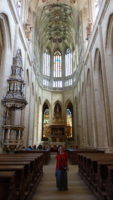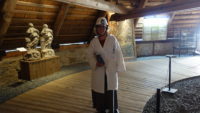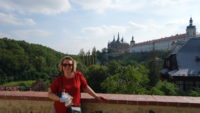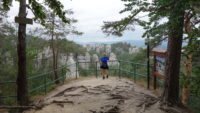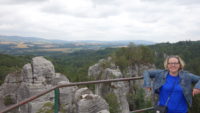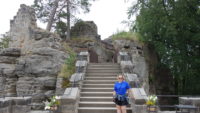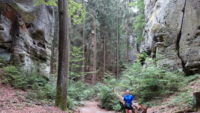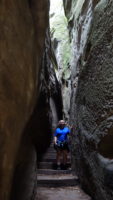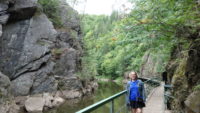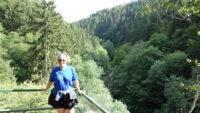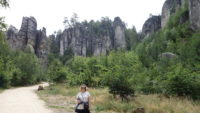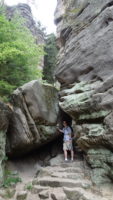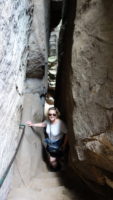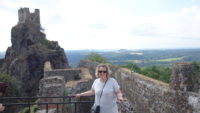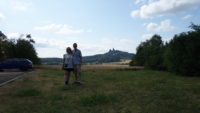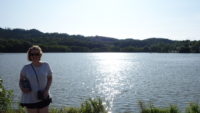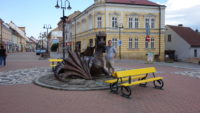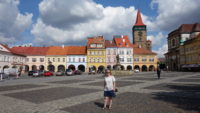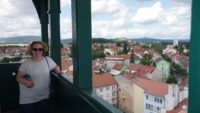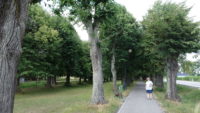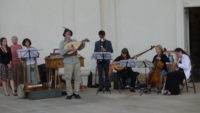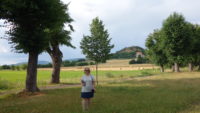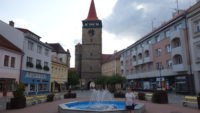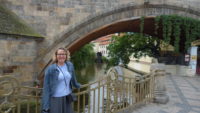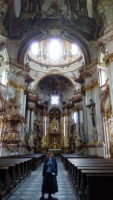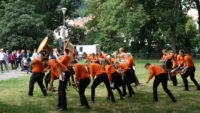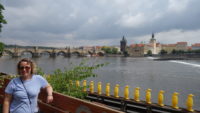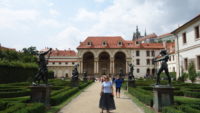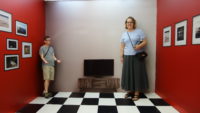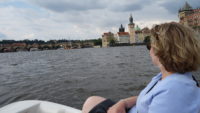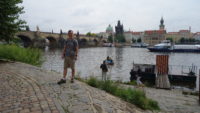M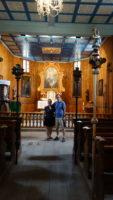 er got us up and moving early this morning, which even included a rare (for Riordans) fifteen-minute time limit on a buffet breakfast. We had to be in the town of Roznov pod Radhostem at 9:00 to meet a private tour guide, so we had to go.
er got us up and moving early this morning, which even included a rare (for Riordans) fifteen-minute time limit on a buffet breakfast. We had to be in the town of Roznov pod Radhostem at 9:00 to meet a private tour guide, so we had to go.
One of the challenges of being ninety-nine percent clueless in a language is the frustrating inability to read signs. This especially is true in all things driving-related. Once in town, it was not clear where we could legally park. Our strategy, which has worked so far, has been for me to stay with the car in case I am asked to move it, and Mer goes in somewhere and asks someone about parking. Or, in some cases, we figure if we have to pay something, we are okay. Today was both – Mer asked someone, and she sent us to a nearby pay lot.
With the car sorted out, we walked over to the Wallachian Open-Air Folk Museum, a museum that is dedicated to preserving the buildings and lifestyle of the inhabitants from the region’s past. We have been to several such museums in the States and in Ireland and in Scotland. In the Wallachian museum, the buildings seemed to be largely from the 1800s, with a few older. They were either moved from their original locations, or replicas were built.
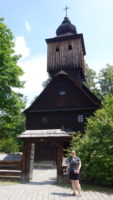 We usually will splurge for a private guide at least once on our trips. We have found private guides to be very helpful in pointing out what is important and in filling in details and stories that are not found on the information cards. Our guide, we found out at the end, was giving one of his first English-language tours for the museum, and he apologized for being nervous. We thought he did quite well. For about two hours, he led us around the three sections of the museum, and even though there were only the three of us, because he was a guide, the docent actors at each place activated the machinery (in the mills) to show us how it worked. It was great.
We usually will splurge for a private guide at least once on our trips. We have found private guides to be very helpful in pointing out what is important and in filling in details and stories that are not found on the information cards. Our guide, we found out at the end, was giving one of his first English-language tours for the museum, and he apologized for being nervous. We thought he did quite well. For about two hours, he led us around the three sections of the museum, and even though there were only the three of us, because he was a guide, the docent actors at each place activated the machinery (in the mills) to show us how it worked. It was great.
We started off in the technology and mill section, which consisted of a barn of wagons, carriages, and farming equipment, including a very clever horse-drawn reaper and raking machine. We then moved on to the functioning mills, starting with the iron mill, which is like a blacksmith’s shop on steroids. One of the fascinating things to me was how ingenious people were at harnessing water power. In the iron mill, they could turn water on and off to power a huge bellows, a giant iron hammer for beating metal, and a sharpening wheel. The ability to arrange simple mechanisms to turn circular motion (the water wheel) into up-and-down motion for the bellows or lifting motion for the hammers was interesting to see. There were some terribly clever people around.
We also went to a felting mill, where giant hammers pounded cloth into felt. We saw a grist mill, where grain was ground and then sorted into chaff and wheat. We got to see a functioning sawmill, where the water powered both the up-and-down saw and the horizontal motion of the log against the saw. We saw a human-powered flax-seed oil press, which took several steps and ended with huge beams being screwed together. A common refrain from our guide was “it was hard work,” including the alarming fact that childhood mortality in flour millers’ families was eighty percent, exacerbated by breathing the flour dust (compared to fifty percent childhood mortality in the general population).
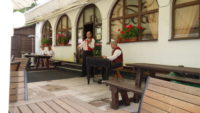 We left the mill section behind and crossed over to the wooden town. These buildings were from town folk, so it had a pub, a church, a mayor’s house, and some other buildings. Around the church was a small graveyard that contained memorials or even the final resting places of about forty of the area’s famous people, who were mostly sports figures. Each headstone was unique and tended to be artistically interesting, often symbolically showing what the person was best known for.
We left the mill section behind and crossed over to the wooden town. These buildings were from town folk, so it had a pub, a church, a mayor’s house, and some other buildings. Around the church was a small graveyard that contained memorials or even the final resting places of about forty of the area’s famous people, who were mostly sports figures. Each headstone was unique and tended to be artistically interesting, often symbolically showing what the person was best known for.
The church itself was beautiful, with almost all of the building made of wood, including the organ pipes. In this particular church, there was a blue roof that was striking, but our guide said that was not typical of churches in the area. I thought the church felt very warm from all of the wood, and it was intimate in its size.
The mayor’s house belonged to the richest man in town, and the mayor was not an elected position – when the mayor retired, his son took over, but the ex-mayor still had the right to have a room and meals in the house. Several times each year, the mayor would hold dances for the townspeople in his main room, which was about the size of a small school classroom. When not used for dancing, the room was where the mayor and his wife and all of his children slept, with the parents getting the bed and the children sleeping on benches or on top of the earthen part of the stove.
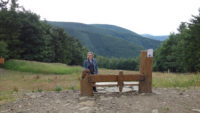 Which leads us to the village – the typical peasant dwellings. These usually had one one room for the entire family, which in one case was thirteen people. They might have some storage rooms attached or stalls for animals, but most of the living happened in the main room. What struck us as we wandered around the homes was that some of them were set up as they had been around 1950, but except for the electric lights and the radio, they looked the same as the 1850 houses. One interesting place we saw was a shepherd’s summer hut – it was set on huge skis so it could be moved across wet grass to new pastures as needed.
Which leads us to the village – the typical peasant dwellings. These usually had one one room for the entire family, which in one case was thirteen people. They might have some storage rooms attached or stalls for animals, but most of the living happened in the main room. What struck us as we wandered around the homes was that some of them were set up as they had been around 1950, but except for the electric lights and the radio, they looked the same as the 1850 houses. One interesting place we saw was a shepherd’s summer hut – it was set on huge skis so it could be moved across wet grass to new pastures as needed.
After the museum, we headed back to the hotel up on the mountain at Pustevny. We ate lunch, and just as we finished, it started raining fairly hard. This was the first real rain we had encountered on this trip, and it put the brakes on Mer’s plan to ride the chairlift down to the valley and back. We debated a bit on what to do, and we got fortunate in that the rain took a break for about thirty minutes, and there were two men playing instruments and singing on the terrace of our hotel, so we sat and listened to them. One played the violin, and the other played a huge and unusual hammered dulcimer. It had a single pedal (like what pianos have) that allowed the strings to play freely or muted them. The upper notes sounded like a dulcimer, and the middle notes sounded a lot like a banjo, and the lower notes sounded somewhat like a piano. The few people around us all seemed to know the songs being sung and mouthed the words or actually sang along. It was a fun backup plan.
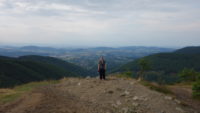 The rain came back, so we went back to the room for about an hour to take stock, after which Mer decided that, as the rain had stopped again, we should try the correct hike that we had failed to do last night. Mer asked at the front desk, and the receptionist showed us a map, so we got it right this time. We hiked along the blue trail, with the goal of reaching the statue of Radegast. Radegast was the Czech god of the sun, the harvest, and friendship before Christianity came along. It seems J. R. R. Tolkien knew his Slavic mythology, as he named a wizard in The Lord of the Rings Radegast. Along the way, we came to a large vista overlooking the valley serviced by the chairlift, so we still got to see what Mer had wanted to see on the lift. We reached the statue, and it was fine, but the viewpoint was the clear highlight of the trip.
The rain came back, so we went back to the room for about an hour to take stock, after which Mer decided that, as the rain had stopped again, we should try the correct hike that we had failed to do last night. Mer asked at the front desk, and the receptionist showed us a map, so we got it right this time. We hiked along the blue trail, with the goal of reaching the statue of Radegast. Radegast was the Czech god of the sun, the harvest, and friendship before Christianity came along. It seems J. R. R. Tolkien knew his Slavic mythology, as he named a wizard in The Lord of the Rings Radegast. Along the way, we came to a large vista overlooking the valley serviced by the chairlift, so we still got to see what Mer had wanted to see on the lift. We reached the statue, and it was fine, but the viewpoint was the clear highlight of the trip.
That left supper, and after supper, I reminded Mer the hotel had a ping pong table, so we played and she beat me 21-18, the closest I have ever come to beating her. If it was 1850, the kids would have to sleep somewhere else so that I could play a rematch.
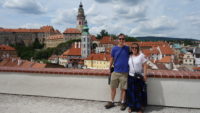 It was another long driving day – over three hours, with a minor detour and a major pain-in-the-butt drive through a small city in stop-and-go-traffic, with a very odd lack of gas stations or rest stops for the final hour or so, but the end result was worth it. We got to Cesky Krumlov.
It was another long driving day – over three hours, with a minor detour and a major pain-in-the-butt drive through a small city in stop-and-go-traffic, with a very odd lack of gas stations or rest stops for the final hour or so, but the end result was worth it. We got to Cesky Krumlov.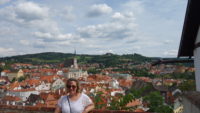 We left the B and B close to 4:00, and I told Meredith that I did not want anything other than a map – I just wanted to wander at whim and get lost. It’s a very small town, and the church or castle is almost always visible, so you can’t get too turned around. We found a small park with an overlook to the castle, and then drifted around until we found the main square, managed to cross the river on one of just two bridges, and puffed our way up the lane into the castle for magnificent views of the main town. It was a good place to linger.
We left the B and B close to 4:00, and I told Meredith that I did not want anything other than a map – I just wanted to wander at whim and get lost. It’s a very small town, and the church or castle is almost always visible, so you can’t get too turned around. We found a small park with an overlook to the castle, and then drifted around until we found the main square, managed to cross the river on one of just two bridges, and puffed our way up the lane into the castle for magnificent views of the main town. It was a good place to linger.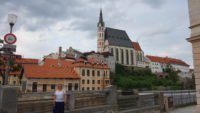 Back we went into the small maze of roads, and across the first bridge again. We found a restaurant our B and B had recommended, and we sat on the terrace next to the river, eating and watching tourists float by in canoes and rafts.
Back we went into the small maze of roads, and across the first bridge again. We found a restaurant our B and B had recommended, and we sat on the terrace next to the river, eating and watching tourists float by in canoes and rafts.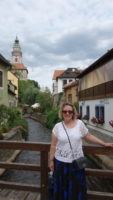 Just to drive the cute theme home, as we were walking back to our B and B outside of the old town, a hot air balloon drifted overhead and went before us as we went home. It may have been hard to get to, and may be full of tourists, but Cesky Krumlov is worth lingering in.
Just to drive the cute theme home, as we were walking back to our B and B outside of the old town, a hot air balloon drifted overhead and went before us as we went home. It may have been hard to get to, and may be full of tourists, but Cesky Krumlov is worth lingering in.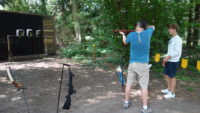
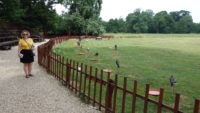
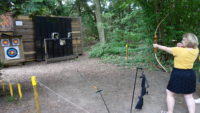
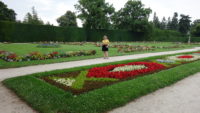
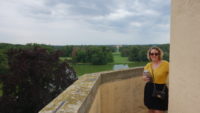
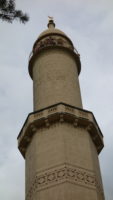
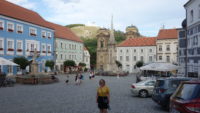
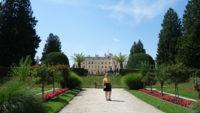
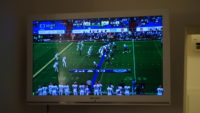
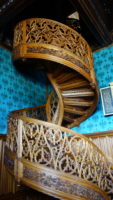
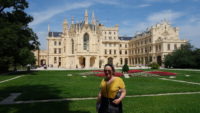





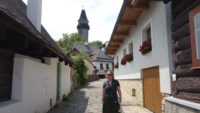
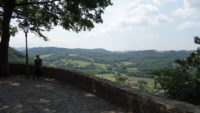
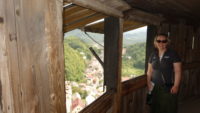
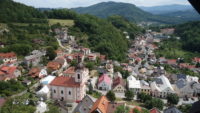
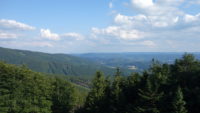
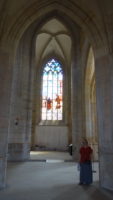
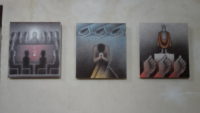 A monk piled up bones into pyramids in the crypt of the church in the 1600s, and then later, in the 1800s, an architect decided to expand that vision into full decorations made out of human bones. It is a bit odd, yes, but the point of these things (and this is the third such place to which we have been in Europe) is that life is short, and then you have to face God. The recording to which we were listening even gave a non-pushy version of the gospel, telling us that these dead were waiting in hope for the resurrection of the dead in Jesus.
A monk piled up bones into pyramids in the crypt of the church in the 1600s, and then later, in the 1800s, an architect decided to expand that vision into full decorations made out of human bones. It is a bit odd, yes, but the point of these things (and this is the third such place to which we have been in Europe) is that life is short, and then you have to face God. The recording to which we were listening even gave a non-pushy version of the gospel, telling us that these dead were waiting in hope for the resurrection of the dead in Jesus.